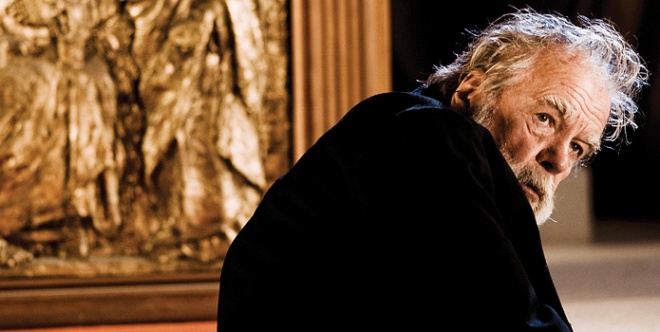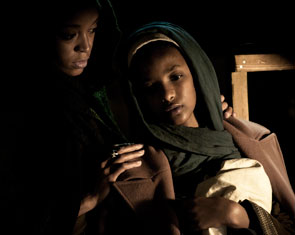Budget and time were tight this year so I only made it to see one film this year at TIFF, despite a short list of five that I really wanted to see. However, the one I saw was well-chosen: The Cardboard Village, or il villaggio di cartone, written and directed by Ermanno Olmi.
It’s always fun to pick out films to watch at a film festival, but this was a no-brainer. One of Olmi’s films made it onto the Vatican’s Best Films List: The Tree of Wooden Clogs. (By the way, Tree of the Wooden Clogs has been #1 on my ziplist for months, but I’m still waiting for it to come! I hope Zip really does have a circulating copy!) But I was also interested in the subject of the film: how does an elderly, retired priest respond to the closing of the parish church he has served in his entire life? The write up that TIFF gave the film suggested a character study, and a compassionate look at the issue of illegal immigrants in Italy (and Europe), an issue that came to a very real crisis in Italy this spring. The film did not disappoint.
 Snapshot
Snapshot
The Cardboard Village is an unhurried, richly-detailed film that rewards those who pay attention to its visual symbolism. It is a parable that intensely explores the imperative to love which lies at the heart of Christianity.
Strengths
The Cardboard Village begins with the dismantling of the interior of a typical small Catholic church, as seen through the eyes of its elderly pastor, who futilely and embarrassingly resists. It’s a scene all too familiar in North America, and is powerfully lensed. The striking cinematography of the crucifix dizzily spinning as it is taken down could disorient the audience as much as it would have the pastor, played by Michael Lonsdale. Lonsdale, who recently acted as one of my favorite monks in Of Gods and Men, gives an understated performance of the paralysis of finding one’s self too old, no longer needed, and perhaps no longer relevant. After the church has closed, he gives a homily to the empty church in which he reveals his own dark night of the soul.
The pastor’s running monologue ranges from amusing to irritating to profound. Yet we need it, because it is in huge contrast with the almost entirely silent, visual narrative of the African refugees who find temporary asylum from the police in the locked-up church. The refugees’ characters are well-sketched visually, but the extremely limited dialogue leaves most of their stories up to the imagination of the audience.
The film takes place almost entirely inside the church, the sacristy, and the rectory. The outdoor shots are completely lacking in detail and simply show the invasive headlights of construction equipment or the police cars coming to detain the immigrants.
The extremely close-up scope, the lack of details, and the overt Christian symbolism make the film more a parable than a realistic narrative, although some moments are strikingly real. It’s up to the audience to imagine the ending, and to interpret the meaning of the characters’ choices that we witness.
 The unmistakable Christian symbolism makes this film a meditation on the true purpose of the Church and the law of love that is the heart of Christian discipleship. What usually happens in a Catholic Church takes place in an unexpected way as the refugees hide in the torn-down church: new life, washing, Eucharist, betrayal and forgiveness, even a reference to sharing the Word of God.
The unmistakable Christian symbolism makes this film a meditation on the true purpose of the Church and the law of love that is the heart of Christian discipleship. What usually happens in a Catholic Church takes place in an unexpected way as the refugees hide in the torn-down church: new life, washing, Eucharist, betrayal and forgiveness, even a reference to sharing the Word of God.
Limitations
Olmi’s choice to bring us into the details of the present moment of the story, without giving a satisfactory sense of what has happened before or what will happen afterwards, can make the film more intense. But the slow pace and attention to exquisite detail could make the pacing seem ponderous. The lack of closure and explicit narrative arc makes the film confusing and perhaps less accessible for some viewers.
The orchestral film score is beautiful but rather than always integrating seamlessly with the narrative, it sometimes draws attention to itself. For some, this might heighten the emotion; for me, this stylistic choice distracts from being present to the most powerful moments of the film.
Window to the Soul?
The Cardboard Village is a powerful visual parable that works on several levels. The spiritual journey of the elderly priest was, for me, the most compelling piece of the film, but the refugee narrative contains wonderful symbolism about the meaning of the Christian life, as well as an invitation to reverence and welcome the Other.
The Cardboard Village (Italian, with English subtitles)
il villaggio di cartone
Written and Directed by Ermanno Olmi
Release in Italy: October 7, 2011
For those who are interested, themes included in the film are:
- Dark night of the soul
- Faith
- The “ordinary” sacramental moments in the life of the Church
- The human condition and the human community
- Illegal refugees and the question of social justice
- Jesus’ law of love
